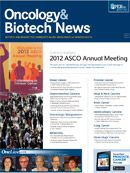Publication
Article
Oncology & Biotech News
Research Further Supports Aflibercept Benefit in Metastatic Colorectal Cancer
Author(s):
The phase III VELOUR trial demonstrated that the addition of aflibercept to FOLFIRI improved overall survival compared with placebo plus FOLFIRI in patients with metastatic colorectal cancer.
Carmen Joseph Allegra, MD
The phase III VELOUR trial demonstrated that the addition of aflibercept (Zaltrap) to FOLFIRI improved overall survival (OS) compared with placebo plus FOLFIRI in patients with metastatic colorectal cancer. Based on the data, the FDA reviewed the drug under its priority review program and an approval was granted on August 3. At ASCO 2012, two studies were presented that offered additional analysis of the VELOUR data.
In the results of a pre-specified subgroup analysis of VELOUR, aflibercept improved both OS and progression- free survival (PFS), regardless of whether patients had received previous treatment with bevacizumab (Avastin).1 Further, the analysis suggested that prior exposure to bevacizumab does not appear to affect the safety profile of aflibercept. The results, however, were not statistically significant.
“Although this was an analysis of a pre-specified subgroup, the study was not adequately powered to show a treatment difference [for aflibercept versus placebo] between the two arms in the subgroup exposed to prior bevacizumab. Therefore, we can draw no definitive conclusions concerning the benefit of aflibercept in the prior bevacizumab-treated subgroup,” explained lead presenter Carmen Joseph Allegra, MD, University of Florida, Gainesville.
Aflibercept is a recombinant human fusion protein that acts as a decoy receptor and prevents the interaction of VEGF-A and VEGF-B and placental growth factor with their receptors.
VELOUR enrolled 1226 patients with metastatic colorectal cancer who progressed during or after oxaliplatin. Patients were randomized 1:1 to receive aflibercept plus FOLFIRI or identical placebo plus FOLFIRI. Only one prior oxaliplatin-containing chemotherapy regimen for metastatic disease was allowed.
A significant advantage in OS and PFS was observed with the addition of aflibercept. For the overall analysis, median PFS was 6.9 months with aflibercept versus 4.67 months for placebo (P = .00007). Median OS was 13.50 months with aflibercept versus 12.06 months with placebo, a significant difference favoring the addition of aflibercept (P = .0032).
In the prespecified analysis related to prior bevacizumab exposure, 186 patients in the aflibercept group and 187 patients in the placebo group received prior bevacizumab. No prior bevacizumab was reported for 426 aflibercept-treated patients and 427 placebo patients.
The majority of patients enrolled in North America had received prior bevacizumab, while about 50% of those treated in Europe had previously received bevacizumab, reflecting practice differences in those areas of the world.
The analysis found no positive interaction between prior bevacizumab treatment and OS or PFS for either treatment arm. For patients previously exposed to bevacizumab, median OS was 12.5 months with aflibercept versus 11.7 months for placebo. For those with no prior bevacizumab exposure, median OS was 13.9 months and 12.4 months, respectively.
Median PFS was 6.7 months for aflibercept versus 3.9 months for placebo in the group previously treated with bevacizumab, and 6.9 months versus 5.4 months, respectively, for those with no previous bevacizumab exposure.
The incidence of treatment-emergent adverse events was similar in the aflibercept arm for those with prior bevacizumab exposure (100%) or no prior bevacizumab exposure (98.9%). Grade 3 and 4 adverse events were reported in 82.5% and 83.9%, respectively, in patients in the aflibercept arm with prior and no prior exposure to bevacizumab.
“Prior therapy with bevacizumab did not alter the pattern of safety. Aflibercept did increase the rate of serious adverse events with or without prior bevacizumab exposure,” Allegra stated. About 25% of those treated with aflibercept with or without prior bevacizumab treatment discontinued treatment due to adverse events.
The most common grade 3 and 4 toxicities in the aflibercept-treated group were neutropenia, diarrhea, asthenia, infections, and stomatitis.
Mean Overall Survival Benefit
A second study based on VELOUR outcomes sought to estimate the mean OS benefit of FOLFIRI combined with aflibercept and was presented at a poster session by lead author Florence Joulain, MSc, Leuven Cancer Institute, Belgium.2
In VELOUR, the difference in median OS between the two treatment arms was 1.4 months. Using loglogistic function, Joulain and co-authors estimated the mean OS benefit for aflibercept plus FOLFIRI to be 2.9 months compared with placebo.
Although median survival is used to gain regulatory approval for a drug, mean survival estimation offers a clinically meaningful estimation of survival benefit for an intervention, explained Joulain et al. Mean survival estimation can be used to make clinical and economic decisions about total costs and outcomes in a study population.
- Allegra CJ, Lakomy R, Tabernero J, et al. Effects of prior bevacizumab (B) use on outcomes from the VELOUR study: A phase III study of aflibercept (Afl) and FOLFIRI in patients (pts) with metastatic colorectal cancer (mCRC) after failure of an oxaliplatin regimen. J Clin Oncol. 2012;30(suppl; abstr 3505).
- Joulain F, Cutsem EV, Iqbal SU, et al. Aflibercept versus placebo in combination with FOLFIRI in previously treated metastatic colorectal cancer (mCRC): Mean overall survival (OS) estimation from a phase III trial (VELOUR). J Clin Oncol. 2012;30(suppl; abstr 3602).










